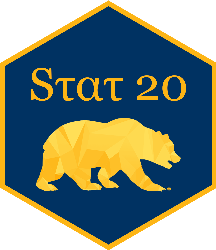| name | species | length |
|---|---|---|
| Gus | Chinstrap | 50.7 |
| Luz | Gentoo | 48.5 |
| Ida | Chinstrap | 52.8 |
| Ola | Gentoo | 44.5 |
| Abe | Adelie | 42.0 |
Bootstrapping
Agenda
- Announcements
- Reading Questions
- Break
- Worksheet: Bootstrapping
- Appendix
Announcements
- Portfolio 5 due Friday at 5pm
- Lab 3 due Wednesday at 12pm
- Quiz 3 next Thursday.
Reading Questions
- Please put your laptops under your desk and your phones away.
- Write your name, ID, and bubble in Version “A” on your answer sheet.
- You may work only with those at your table!
Read this first.
From a population of size 1,000, we take a sample of size 100. We then create a bootstrapped percentile confidence interval for the population median using 10,000 statistics. Each of these statistics was generated from one bootstrap sample.
How large is each bootstrap sample?
- A: 10000
- B: 1000
- C: 100
- D: The correct answer is not listed here.
00:40
Suppose we change the sample size from 100 to something else. Which of the following sizes makes the bootstrap method for creating a confidence interval most prone to failure?
- A: 200
- B: 75
- C: 50
- D: 20
00:40
True or false: a bootstrap sample is taken with replacement.
- A: True
- B: False
00:30
We have obtained a confidence interval for the regression coefficient \(b1\) in the model \(\hat{y} = b_0 + b_1x\) using the bootstrap. The interval for \(b1\) does not contain 0. What does this suggest?
- A: In the population, there is a linear association between \(x\) and \(y\).
- B: Within our table, there is a linear association between \(x\) and \(y\).
- C: In the population, there is no linear association between \(x\) and \(y\).
- D: Within our table, there is no linear association between \(x\) and \(y\).
- E: In the population, there is a causal link between \(x\) and \(y\).
00:30
Break
05:00
Worksheet: Bootstrapping
40:00
Appendix
Concept Questions
Which of these is a valid bootstrap sample?
01:00
| name | species | length |
|---|---|---|
| Ida | Chinstrap | 52.8 |
| Luz | Gentoo | 48.5 |
| Abe | Adelie | 42.0 |
| Ola | Gentoo | 44.5 |
| Ida | Chinstrap | 52.8 |
| name | species | length |
|---|---|---|
| Ola | Gentoo | 44.5 |
| Gus | Chinstrap | 50.7 |
| Ida | Chinstrap | 52.8 |
| Luz | Gentoo | 48.5 |
| Gus | Chinstrap | 50.7 |
| Gus | Chinstrap | 50.7 |
| name | species | length |
|---|---|---|
| Gus | Chinstrap | 50.7 |
| Ola | Gentoo | 48.5 |
| Ola | Chinstrap | 52.8 |
| Ida | Gentoo | 44.5 |
| Ida | Adelie | 42.0 |
| name | species | length |
|---|---|---|
| Gus | Chinstrap | 50.7 |
| Abe | Adelie | 42.0 |
| Gus | Chinstrap | 50.7 |
| Gus | Chinstrap | 50.7 |
| Gus | Chinstrap | 50.7 |
The Bootstrap
Parameters and Statistics
Our Goal: Assess the sampling variability in our estimate of the median year at Cal and the proportion of students in an econ-related field.
Our Tool: The Bootstrap
Collecting a sample of data
If you’ve been given an index card, please write on it:
- Your first name
- Your year at Cal (1 is first year, 2 is second year, etc)
- Whether or not you are interested in majoring in a business- or econ-related field. 1 = yes, 0 = no
boardwork
Bootstrapping with Infer
Example: Penguins
Let’s consider our 344 penguins to be a SRS from the broader population of Antarctic penguins. What is a point and interval estimate for the population proportion of penguins that are Adelie?
Point estimate
Generating one bootstrap sample
Response: is_adelie (factor)
# A tibble: 344 × 2
# Groups: replicate [1]
replicate is_adelie
<int> <fct>
1 1 FALSE
2 1 FALSE
3 1 TRUE
4 1 FALSE
5 1 TRUE
6 1 TRUE
7 1 FALSE
8 1 TRUE
9 1 TRUE
10 1 TRUE
# ℹ 334 more rowsTwo more bootstrap samples
penguins |>
specify(response = is_adelie,
success = "TRUE") |>
generate(reps = 1,
type = "bootstrap")Response: is_adelie (factor)
# A tibble: 344 × 2
# Groups: replicate [1]
replicate is_adelie
<int> <fct>
1 1 FALSE
2 1 TRUE
3 1 FALSE
4 1 FALSE
5 1 FALSE
6 1 TRUE
7 1 TRUE
8 1 FALSE
9 1 FALSE
10 1 FALSE
# ℹ 334 more rowspenguins |>
specify(response = is_adelie,
success = "TRUE") |>
generate(reps = 1,
type = "bootstrap")Response: is_adelie (factor)
# A tibble: 344 × 2
# Groups: replicate [1]
replicate is_adelie
<int> <fct>
1 1 FALSE
2 1 TRUE
3 1 TRUE
4 1 FALSE
5 1 FALSE
6 1 TRUE
7 1 TRUE
8 1 FALSE
9 1 FALSE
10 1 FALSE
# ℹ 334 more rowsVisualizing 9 bs samples
Calculating 9 \(\hat{p}\)
Response: is_adelie (factor)
# A tibble: 9 × 2
replicate stat
<int> <dbl>
1 1 0.404
2 2 0.430
3 3 0.404
4 4 0.433
5 5 0.468
6 6 0.448
7 7 0.427
8 8 0.413
9 9 0.474Note the change in data frame size.
The bootstrap dist (reps = 500)
Interval Estimate
We can extract the middle 95% by identifying the .025 quantile and the .975 quantile of the bootstrap distribution with get_ci().
# A tibble: 1 × 2
lower_ci upper_ci
<dbl> <dbl>
1 0.392 0.494Documentation: infer.tidymodels.org

Your Turn
Create a 95% confidence interval for the median bill length of penguins.
05:00



